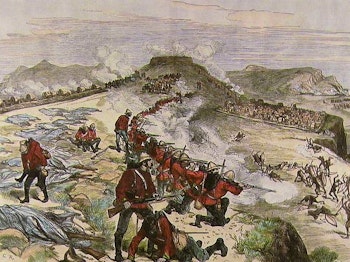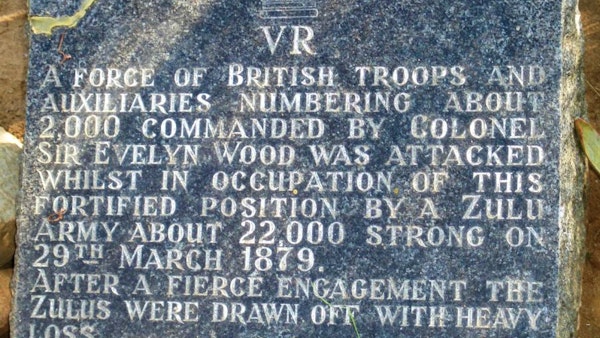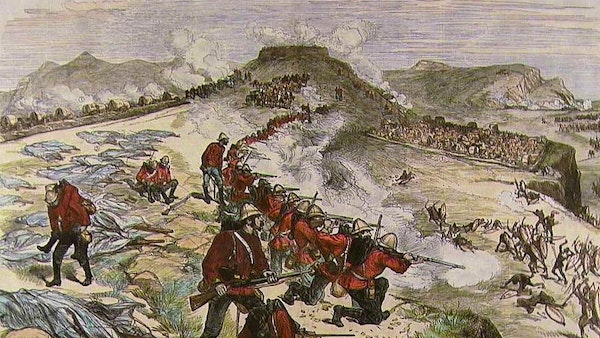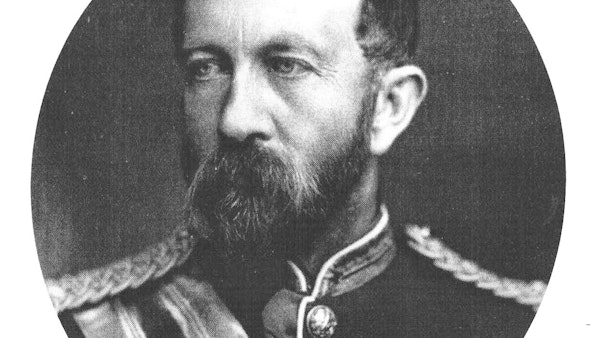Battle Of Kambula
Description
Battle of Kambula 29 March 1879. During the Anglo-Zulu War when a Zulu Army attacked the British camp at Kambula. It resulted in a decisive Zulu defeat and is considered to be the turning point of the Anglo-Zulu War. Prelude Following the disaster at Hlobane on 28 March 1879, Colonel Evelyn Wood’s forces prepared to receive an attack by the entire Zulu impi, of which they had only previously encountered the leading sections. Soon after dawn of 29 March, Transvaal Rangers rode out to locate the enemy impi, the cattle were put out to graze and, after some deliberation, two companies were despatched to collect firewood. By 11am the Rangers had returned with the news that the Zulu impi was on the move and was to attack Kambula at noon and was nearly 20,000 men strong. Consisting of regiments that had already defeated the British at Isandlwana and other battles and that many of the Zulus were armed with rifles taken from the British dead at these battles. Shortly after this the Zulu impi was sighted 5 miles away across the plain, coming on due westwards in five columns an alarm being sounded. However, the warriors of the Zulu impi had not eaten for three days. Cetshwayo responded to pleas from the abaQulasi for aid against the raids of Wood's troops by ordering the main Zulu army to help them. He ordered it not to attack fortified positions but to lure the British troops into the open even if it had to march on the Transvaal to accomplish this. His orders were not followed. The impi moved and Wood initially thought it was advancing on the Transvaal but it halted a few miles south of Kambula and formed up for an attack.
Kambula’s defences The defences on Kambula consisted of a hexagonal laager formed with wagons that were tightly locked together, and a separate kraal for the cattle, constructed on the edge of the southern face of the ridge. Trenches and earth parapets surrounded both sections, and a stone-built redoubt had been built on a rise just north of the kraal. Four 7-pounders canons were positioned between the redoubt and the laager to cover the northern approaches. Two more guns in the redoubt covered the north-east.
In all, Wood’s force mustered 121 Royal Artillery and Engineers, 1,238 infantry and 638 mounted men. With headquarters staff, it totalled 2,000 men, of which 88 were sick in hospital. At 12.45 on 29 March 1879, the tents were struck, reserve ammunition was distributed, and the troops took up their battle stations. As the troops moved to their posts they could see the Zulu right horn, circling north out of British artillery range before halting north-west of the camp. The left horn and centre of the impi continued westwards until they were due south of Kambula. At 1.30 Lieutenant-Colonel Redvers Henry Buller men rode out to within range of the massed Zulus, fired a volley and then galloped. The Zulu attack , closely followed by a great wave of 11,000 Zulu warriors. As soon as the horsemen had reached Kambula, and cleared the field of fire, the British infantry opened fire with support from their four 7-pounders firing shell, and then when the Zulus got closer canister shot. A small number of Zulus managed to burst into the laager, and were repelled with bayonets, while the bulk of the advance was held at bay by the steady British musketry and gunfire. Some of the Zulu force swung right to come in against the western sides of the laager, but were met with equally effective resistance. After about half an hour the Zulu right horn drew back to the north-east.At 2.15, as the right horn made its withdrawal, the left horn and centre surged up out of the ravine, their leading warriors falling to crossfire from the laager and kraal as they came over the crest. However, more and more swarmed on to the glacis between the cliff and the defenders, funneling into the gap between the kraal and laager. The Zulus soon forced their way into the cattle Kraal and fought hand-to-hand with men of the 1/13th company. The cattle in the kraal hampered both sides, but with Zulu pressure mounting up the heavily outnumbered British troops managed to extricate themselves and pull back to the redoubt. Zulu riflemen were now able to open fire from behind the walls of the kraal to give their advancing comrades cover. At about this time the right horn came on again from the north-east, charging across the north face of the redoubt towards the guns and the eastern sides of the laager. Although now attacked on both sides, Wood appreciated that the situation to the south was critical and ordered two companies to clear the Zulus off the glacis. Led by Major Hackett the men formed in line with bayonets fixed and charged across the open ground,
forcing the Zulus back over the rim. The troops then lined the crest and opened volley fire The counter-attack had succeeded perfectly but Hackett’s men suddenly found themselves under fire from their right, where Zulu marksmen had concealed themselves. Hackett sounded the 'Retire' and his men returned to the cover of the laager, but not before losing a sergeant, a subaltern and himself receiving a blinding head wound. The sight of this withdrawal encouraged the Zulus in the ravine to charge again, but along the narrow killing zone in front of the laager they could not this time prevail against the controlled volleys from behind the wagons and the redoubt
On the north side the Royal Artillery men fought their guns in the open, not taking cover, The Zulus charged again and again, with unwavering courage, but the head of each charge was shot away. Then the Zulus began to pull away eastwards Over 1800 Zulu lost there lives. 29 British soldiers were killed, and 64 men wounded.
Kambula is considered as the turning point of the Anglo Aulu War, for the shield and assegai were no match for an entrenched force with artillery and rifles. Use of a guide is recomended to enhance your experiance of the site Phone 0834593697
Map
Click here to see more accommodation options
You may also be interested in browsing our selection of accommodation in or reading about






